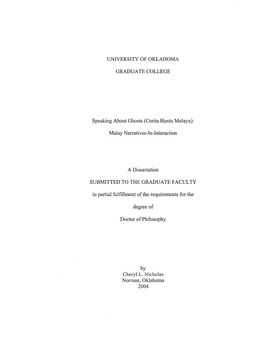| dc.contributor.advisor | Wieder, D. Lawrence, | en_US |
| dc.contributor.advisor | Rodriguez, Clemencia, | en_US |
| dc.contributor.author | Nicholas, Cheryl L. | en_US |
| dc.date.accessioned | 2013-08-16T12:20:51Z | |
| dc.date.available | 2013-08-16T12:20:51Z | |
| dc.date.issued | 2004 | en_US |
| dc.identifier.uri | https://hdl.handle.net/11244/1234 | |
| dc.description.abstract | This dissertation is divided into two parts. In Part One I discuss the literature associated with narrative to make a case for how narrative influences social reality. I find the monologic view of storytelling problematic as it tends to essentialize culture and regard reality as a fixed entity. My intention is to observe how social reality is exhibited in the intercises of performance, setting and interaction. The contribution of this study is to recognize the functional and organic associations between the monologic, interactive and performative spheres of storytelling. I also provide background information on the Malay world view along with accounts of Malaysian history and belief systems. | en_US |
| dc.description.abstract | My interest in Malay cerita hantu (ghost stories), for purposes of this dissertation, holds primarily to the way these narratives are used in everyday conversation by Malaysia's Malay community as a way to talk about their social reality. I choose to examine cerita hantu holistically---my exploration into ghost stories does not only attend to these stories' content or their semiotic, but also of the performative, interactive and contextual elements in the telling of the story. | en_US |
| dc.description.abstract | In Part Two, I discuss my research findings. My analysis is based on Goffman's dramaturgical metaphor (particularly his concept of the working consensus) and frame analysis. For my analysis, I use strips of talk from cerita hantu and talk about cerita hantu which I collected from interactions while in the field. I show how in interactive sequences, the interactants' working consensus (as situated in a particular interaction) and (in some cases keyed) primary frameworks operates both, as (1) a sense-making device for the interactants, and (2) an intervention for meanings as formulated in interaction. I found that items such as time and spatial arrangements; socio-cultural organizations such as age, locality and identity and belief systems; along with normative constructs around socialization; and, remnants of the colonial experience are all parts of the Malay world view that are constituted in talk. Such exhibitions of social order are made around and about (in many cases with extreme seriousness) the accounting for the presence of hantu in the Malay world. | en_US |
| dc.format.extent | xii, 230 leaves : | en_US |
| dc.subject | Social interaction. | en_US |
| dc.subject | Goffman, Erving Criticism and interpretation. | en_US |
| dc.subject | Oral tradition Malaysia. | en_US |
| dc.subject | Narration (Rhetoric) | en_US |
| dc.subject | Malays (Asian people) Folklore. | en_US |
| dc.subject | Rhetoric. | en_US |
| dc.subject | Speech Communication. | en_US |
| dc.subject | Anthropology, Cultural. | en_US |
| dc.title | Speaking about ghosts (cerita hantu melayu): Malay narratives-in-interaction. | en_US |
| dc.type | Thesis | en_US |
| dc.thesis.degree | Ph.D. | en_US |
| dc.thesis.degreeDiscipline | Department of Communication | en_US |
| dc.note | Advisers: D. Lawrence Wieder; Clemencia Rodriguez. | en_US |
| dc.note | Source: Dissertation Abstracts International, Volume: 68-06, Section: A, page: 2244. | en_US |
| ou.identifier | (UMI)AAI3270682 | en_US |
| ou.group | College of Arts and Sciences::Department of Communication | |
